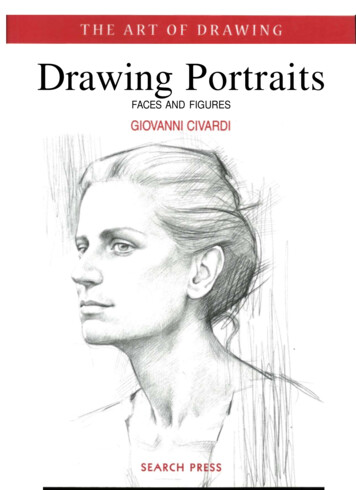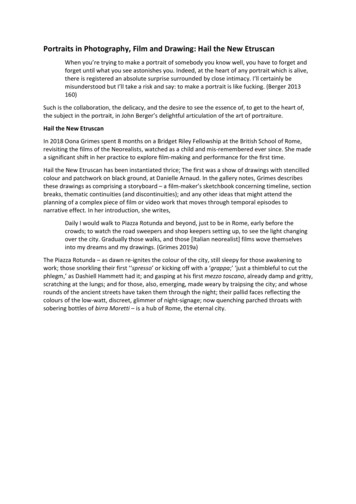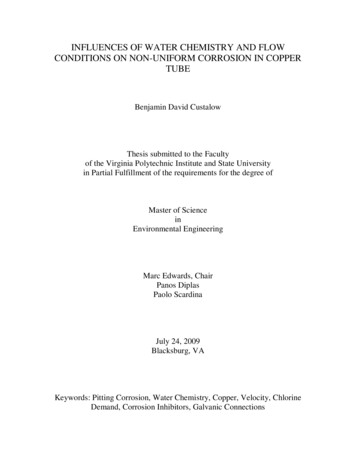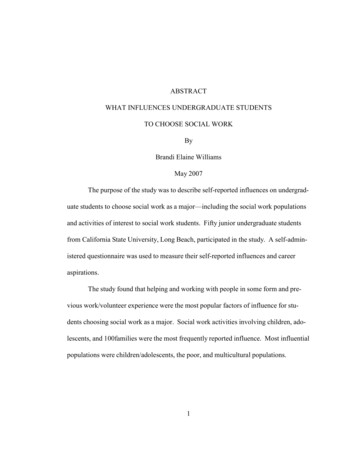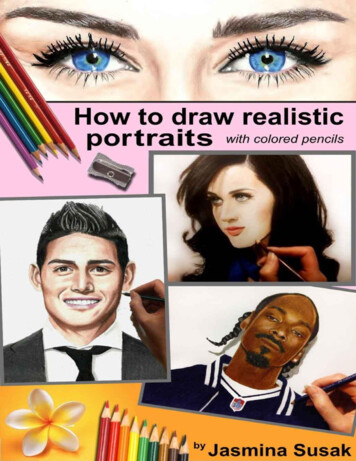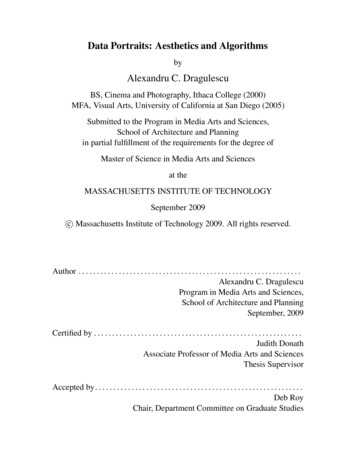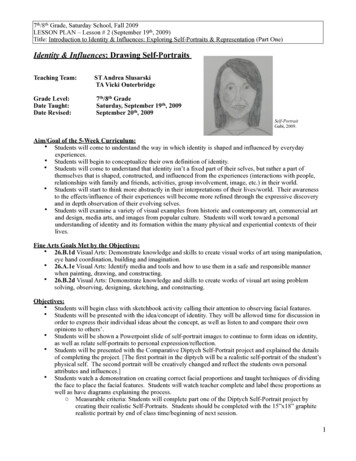
Transcription
7th/8th Grade, Saturday School, Fall 2009LESSON PLAN – Lesson # 2 (September 19th, 2009)Title: Introduction to Identity & Influences: Exploring Self-Portraits & Representation (Part One)Identity & Influences: Drawing Self-PortraitsTeaching Team:ST Andrea SlusarskiTA Vicki OuterbridgeGrade Level:Date Taught:Date Revised:7th/8th GradeSaturday, September 19th, 2009September 20th, 2009Self-PortraitGabi, 2009.Aim/Goal of the 5-Week Curriculum: Students will come to understand the way in which identity is shaped and influenced by everydayexperiences. Students will begin to conceptualize their own definition of identity. Students will come to understand that identity isn’t a fixed part of their selves, but rather a part ofthemselves that is shaped, constructed, and influenced from the experiences (interactions with people,relationships with family and friends, activities, group involvement, image, etc.) in their world. Students will start to think more abstractly in their interpretations of their lives/world. Their awarenessto the effects/influence of their experiences will become more refined through the expressive discoveryand in depth observation of their evolving selves. Students will examine a variety of visual examples from historic and contemporary art, commercial artand design, media arts, and images from popular culture. Students will work toward a personalunderstanding of identity and its formation within the many physical and experiential contexts of theirlives.Fine Arts Goals Met by the Objectives: 26.B.1d Visual Arts: Demonstrate knowledge and skills to create visual works of art using manipulation,eye hand coordination, building and imagination. 26.A.1e Visual Arts: Identify media and tools and how to use them in a safe and responsible mannerwhen painting, drawing, and constructing. 26.B.2d Visual Arts: Demonstrate knowledge and skills to create works of visual art using problemsolving, observing, designing, sketching, and constructing.Objectives: Students will begin class with sketchbook activity calling their attention to observing facial features. Students will be presented with the idea/concept of identity. They will be allowed time for discussion inorder to express their individual ideas about the concept, as well as listen to and compare their ownopinions to others’. Students will be shown a Powerpoint slide of self-portrait images to continue to form ideas on identity,as well as relate self-portraits to personal expression/reflection. Students will be presented with the Comparative Diptych Self-Portrait project and explained the detailsof completing the project. [The first portrait in the diptych will be a realistic self-portrait of the student’sphysical self. The second portrait will be creatively changed and reflect the students own personalattributes and influences.] Students watch a demonstration on creating correct facial proportions and taught techniques of dividingthe face to place the facial features. Students will watch teacher complete and label these proportions aswell as have diagrams explaining the process.o Measurable criteria: Students will complete part one of the Diptych Self-Portrait project bycreating their realistic Self-Portraits. Students should be completed with the 15”x18” graphiterealistic portrait by end of class time/beginning of next session.1
7th/8th Grade, Saturday School, Fall 2009LESSON PLAN – Lesson # 2 (September 19th, 2009)Title: Introduction to Identity & Influences: Exploring Self-Portraits & Representation (Part One)oTimeframe (180 minutes): Students will start the class with a ten-minute sketchbook activity.Followed by a twenty to twenty-five minute teacher-lead discussion and ten-minutedemonstration. Next, students will be given 120 minutes to start and work on the first selfportrait in the diptych. Ending of the class time will include a five-minute clean up and tenminutes allotted for closing discussion.Vocabulary:Production: Self-Portrait: a pictorial portrait of oneself, done by oneself. Diptych: A work of art composed to two pieces together. Line: A mark made by a pencil, brush, or the like, that defines the contour of a shape. Shading/Value: The representation of the different values of color or light and dark in a drawing. Proportion: proper relation between things or parts; relative size or extent. Identity: The collective aspect of the set of characteristics by which a thing is definitively recognizableor known. Identify: To recognize or establish as being a particular person or thing; verify the identity of. Express: to set forth the opinions, feelings, etc., of (oneself), as in speaking, writing, or painting Represent: To serve to express, designate, stand for, or denote, as a word, symbol, or the like does;symbolize. Influence: The action or process of producing effects on the actions, behaviors, opinions, etc. of oneself. Juxtaposition: An act or instance of placing close together or side by side, esp. for comparison orcontrast.Teacher Materials (10 Students plus demos): Media Cart Teacher generated PowerPoint presentation containing discussion topics about Identity and relatedexamples of Self-Portraits. Demo Materials:o 15” x 18” sheets of drawing papero Drawing Pencils (6B, 2B, HB, 3H, Ebony)o Mirroro Rulero Handout about Portrait Drawingo Handout describing the Diptych Projecto Created Posters outlining proportion of the face For Student:o Student’s Sketchbookso 15” x 18” sheet of drawing papero Sheet of Sketching papero Assorted Drawing Pencils (6B, 2B, HB, 3H, Ebony)o Blending Stumpso Kneaded Eraserso Pink Pearl Eraserso Student’s Printed Photo Imageo (1) Handout about Portrait Drawingo (1) Handout outlining the Diptych Projecto (1) Sketchbook Activity Handout Teacher made exemplar:o (1) Completed Realistic Self-Portraito (1) Completed ‘Influenced’ Self-Portrait Multicultural/Historical exemplars:o Resource Poster – Girl In Beret Corot (Pencil Drawing of girl)o Resource Poster – Self-Portrait Andy Warhol. 1988. (Example of different types of portrait)2
7th/8th Grade, Saturday School, Fall 2009LESSON PLAN – Lesson # 2 (September 19th, 2009)Title: Introduction to Identity & Influences: Exploring Self-Portraits & Representation (Part One)oooooooooResource Poster – The Pleasure Principle Magritte. 1937. (Example way to approachrepresentation of self/image of human)Resource Poster – Drawing Hands Escher (Example of Graphite artwork)Printed Images – Collection of Graphite Drawn Self-Portraits (no artists)Printed Images – Collection of examples shown in PowerpointBook – The Self-Portrait in Art. Lerner, Sharon. Minneapolis: Lerner Publications Company,1965.The Encyclopedia of Drawing Techniques. Hanzel Harrison. (Pg. 136-137 about PortraitStudies)Leonardo DaVinci: Art for Children. Ernot Rabott. (Good images of faces also sketchedDaVinci Self-Portrait)Van Gogh. Bruce Bernard. (Pg. 46-47 “A heroic Self-Portrait”)Constrvctive Anatomy. G. Bridgman (Pg. 128-147 – Good examples of facial features)Learner Materials: (10) (10) Student’s Sketchbooks (30) Drawing Pencils (assorted 6B, HB, 3H, Ebony) (30) Markers (20) Sharpies (15) Technical Pens (15) Boxes of Colored Pencils (15) Boxes of Oil/Chalk Pastels (15) Watercolors (30) Assorted Watercolor Brushes (12) Water containers Erasers Glue Sticks (30) 11”x17” sheets of Sketching Paper (15) 15”x18” sheets of Drawing Paper for Project (15) Handout: Self-Portrait Drawing (15) Handout: Diptych Project Description Student’s Printed Photo ImagesMotivation/Activities and Prompts: Teacher created PowerPoint presentation introducing Identity Ideas and Influences, explored throughhistorical references of the Self-Portrait. Discussion questions from Powerpoint and teacher-made exemplars Historical/Multicultural exemplars (Included in Powerpoint):o Self-Portrait. Chuck Closeo Self-Portrait (Black & White). Chuck Close.o Autorretarto con Collre de Espinas u Colibri. Frida Kahlo. 1940.o Las Dos Fridas. Frida Kahlo.o The Art of Painting/The Painter in His Studio. Vermeer. 17th centuryo Self-Portrait in front of the Easel. Vincent Van Gogh. Oil on Canvas. 1888.o Self-Portrait with Straw Hat. Vincent Van Gogh. Oil on Canvas. 1889.o The Art of Painting/The Painter in His Studio. Vermeer. 17th centuryo Self-Portrait. Vermeer. 17th century.o Big Family. Zhang Xiaogang. Lithograph. 2003o Bloodline: Boy. Zhang Xiaogang. Oil on Canvas. 1995.o Self-Portrait. Picasso. 1907o Self-Portrait with Cloak. Picasso. 1901 Historical/Multicultural exemplars (Hung in Classroom)3
7th/8th Grade, Saturday School, Fall 2009LESSON PLAN – Lesson # 2 (September 19th, 2009)Title: Introduction to Identity & Influences: Exploring Self-Portraits & Representation (Part One)oooooooooSelf-Portrait Max BeckmanWoman with Hat Picasso. 1881.Man in Vest William Johnson. 1940Portrait of the Artist Van Gogh. 1889.A Boy with a Lute. Franz HalsSelf-Portrait DurerThe Artist’s Studio Corot. 1796.Woman with Mango. Gauguin. 1848.Vendadora de Alcatraces. Diego Rivera 1840.Classroom Layout/Physical Set-Up: WALL POSTINGS:o Generated Classroom Rules on back wall.o Posters (stated in “Multicultural Exemplars” to be hung on back wall)o Teacher Made Exemplars hung on the back wall for demo and discussion TABLE FORMATION:o Student Work Tables put in (4) large squares, in the back of the room. Basic materials such asdrawing pencils, marker, erasers, and pens will be placed in a container for each student on eachtable.o For discussion and Powerpoint, students will bring their chairs to the front of the classroom tobe together in a group in front of presentation screen.o Tables (“Supply Table” in diagram) will be arranged along the wall opposite the classroom doorwhere the additional art materials necessary for the lesson will be placed. Student sketchbooks,nametags and handout will also be located on these tables.o A demonstration table will be placed in the front of the room.4
7th/8th Grade, Saturday School, Fall 2009LESSON PLAN – Lesson # 2 (September 19th, 2009)Title: Introduction to Identity & Influences: Exploring Self-Portraits & Representation (Part One)Images: Media Cart and Presentation AreaName“TAG” (from LP1) distribution on supply table MATERIALS DISTRIBUTION AREA:o Student sketchbooks, nametags, additional supplies, and handouts will be located on the supplytables arranged along the opposite wall of the classroom.o Materials distributed to each students:- (2) Handouts; project description and one of self-portrait drawing- (1) Sheet of 15”x18” drawing paper for project- Sheets of practice/sketch paper DEMONSTRATION AREA:o Media Carto Demonstration table will be positioned in the front of the room.o Whiteboard at front of classroom will be used for drawing demonstration. CLEAN UP AREA:o Garbage Cans placed around the roomo Students will be asked to return materials, sketchbooks, and nametags to the appropriatelocations.o Drawings will be collected and placed on cart for use next class period.5
7th/8th Grade, Saturday School, Fall 2009LESSON PLAN – Lesson # 2 (September 19th, 2009)Title: Introduction to Identity & Influences: Exploring Self-Portraits & Representation (Part One)Procedures: SKETCHBOOK ACTIVITY: (10 minutes)o Students will be looking at facial features and sketching of the shapes used in portrait drawing.o Students will be encouraged to use materials they are not familiar with for practice. SketchbookPrompt (sheet on tables) – “In sketchbook, observe the person next to you’s facial features(eyes, nose, mouth, etc), what makes them unique and describe who they are? Now practicemaking sketches of the shapes of eyes, mouths, noses, etc.” INTRODUCTION: (5 minutes)o Give a clear, slow introduction. Calm down.o Purpose of introduction to make students aware of what they will be doing today and why theywill be doing it.o Go over class schedule . . .o “Hey guys! Well first, my name is Andrea, and I’m going to be taking over now as your leadteacher. I hope you guys are as excited as I am, and hopefully we can make some really greatworks of art in the times I get to be your teacher. But for today we have a lot to get done tostart our first project . . .”- Powerpoint/Discussion “To start off we are going to have a little discussion aboutIdentity and what it is, and look at some self-portraits to helplead us into our new project, which will be a really cool diptychself-portrait . . .”- Demonstration – “After we look at those works, I’m going to demo some techniques andhints about facial features and correct proportions that will help youachieve a good realism in your first portraits.”- Work Time – “Then for about 120 minutes you’ll have time to start working andhopefully finishing up the first portrait in our diptych project. Followedup with a quick clean up and a few questions at the end of class. Soundlike a plan? Well if you guys want to bring your chairs up here to thefront quietly we can get going on our discussion!” DISCUSSION: (25 minutes)o PowerPoint Presentation and Interactive Discussiono Essential Questions/Script:- First begin Powerpoint/discussion with getting students to question and think aboutidentity. “What is your definition of Identity?”“Well the dictionary says identity is the condition of being oneself and not andnot another and/or the collective aspect of the set of characteristics by whicha thing is definitively recognizable or known. But that’s kind of big isn’t it? SoI made up my own definition of identity, and I think it is a description andcollection of what matters to us that is brought together to express who we areas individuals.”- How is a Self-Portrait a reflection of your Identity?“Is it a reflection because it shows our physical appearance and what peopleand can tell who we are?”- Chuck Close Images – Point out black/white image to how it’s close to what we arecreating that day- Frida Kahlo – Self-Portrait and Los Dos FridasWhat do you see happening in this portrait?What can th
(15) Handout: Self-Portrait Drawing (15) Handout: Diptych Project Description Student’s Printed Photo Images Motivation/Activities and Prompts: Teacher created PowerPoint presentation introducing Identity Ideas and Influences, explored through historical references of the Self-Portrait. Discussion questions from Powerpoint and teacher-made exemplars Historical .
